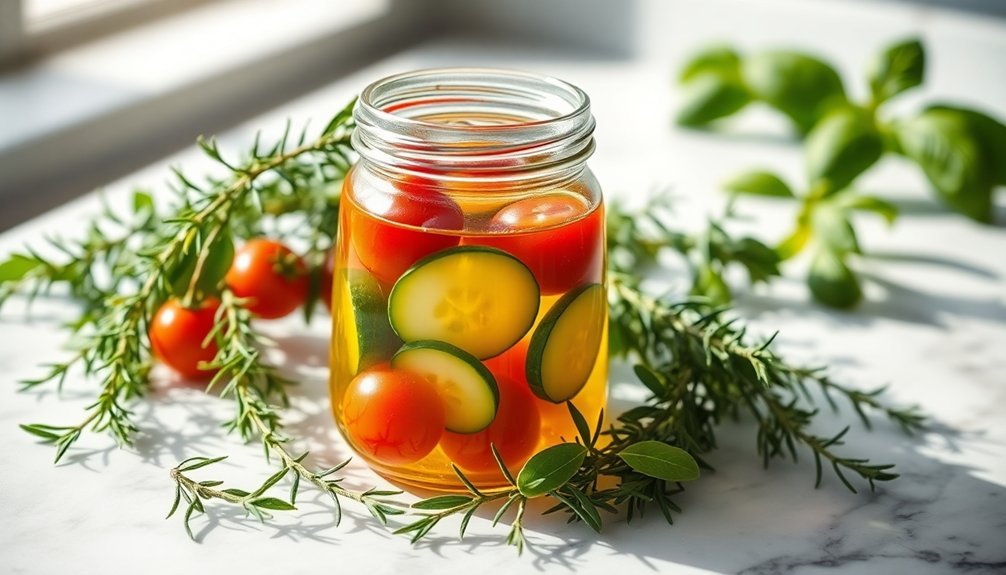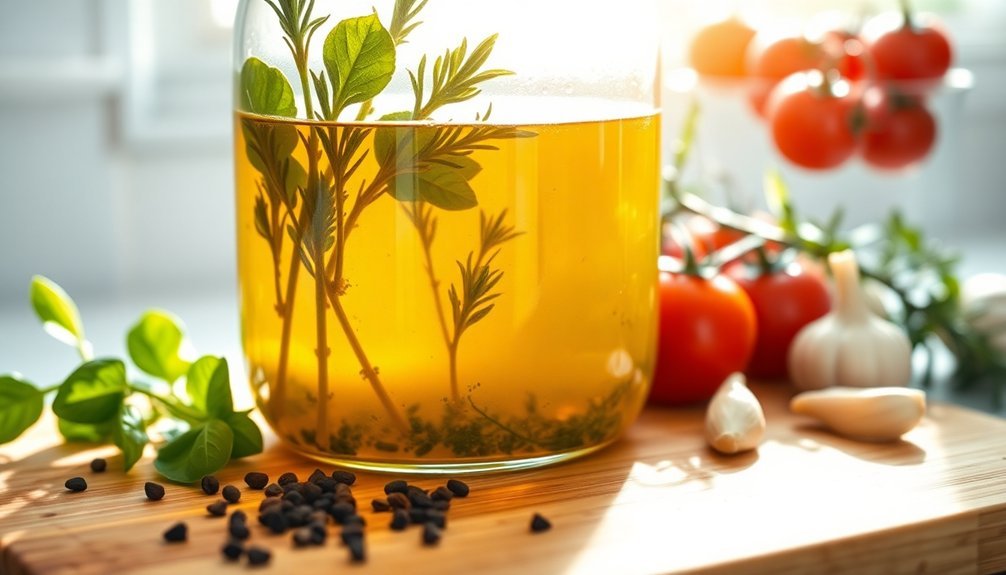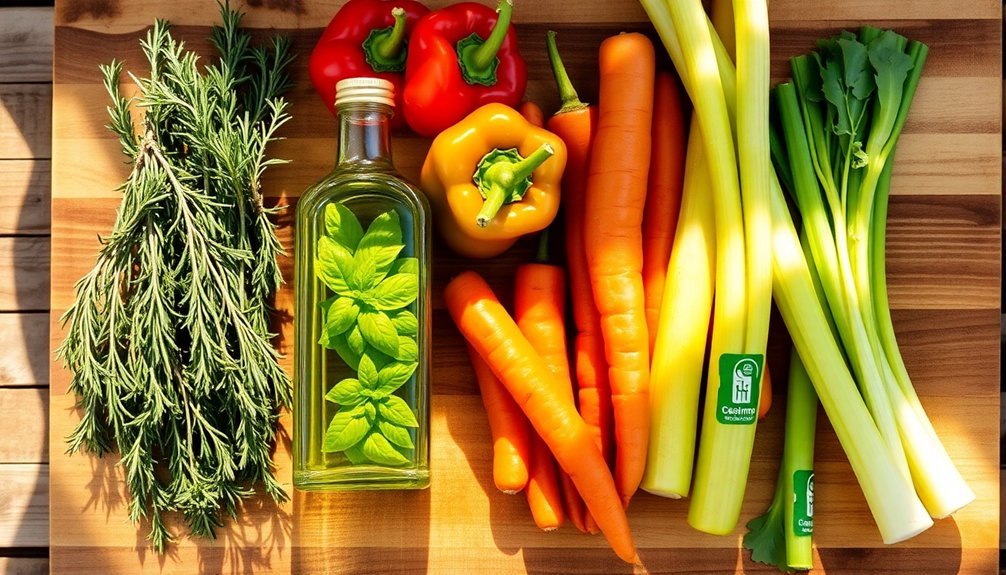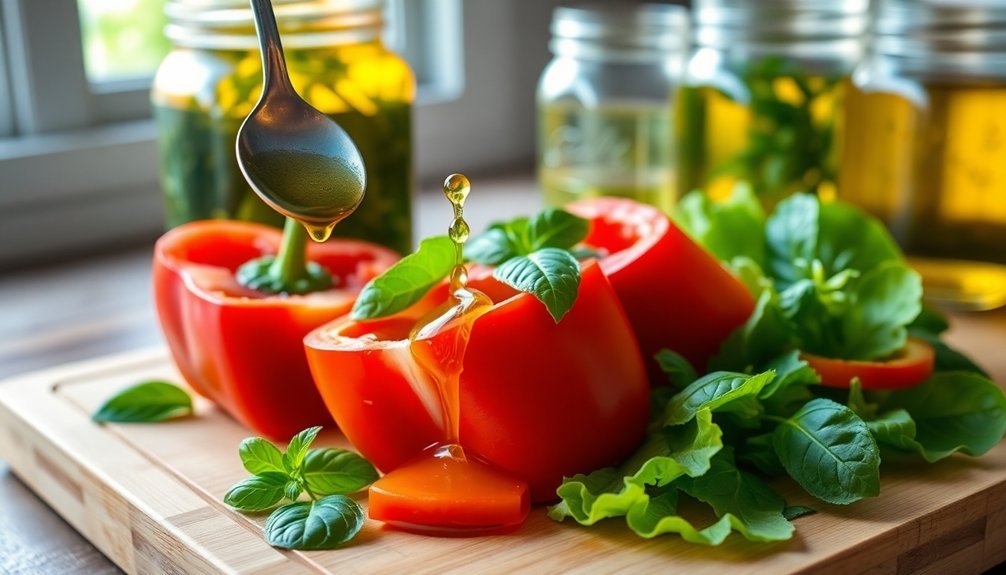You'll extend your vegetables' freshness with these seven herbal oil preservation methods. Start by combining rosemary, thyme, or sage with olive oil to create natural antimicrobial barriers. Always store your herbal-infused mixtures below 39°F to prevent bacterial growth, and use dark glass containers to protect from light degradation. Maintain a proper acid-to-oil balance using vinegar, and guarantee vegetables are completely dry before submerging. Choose high-acid vegetables like sun-dried tomatoes for longer shelf life, and incorporate natural preservatives such as vitamin E. Follow these techniques with precision, and you'll discover even more ways to keep your produce market-fresh.
The Power of Herbal Combinations

You'll discover that herbs like rosemary, thyme, and sage add robust flavors while enhancing both aroma and visual appeal. When you combine these herbs with vegetables in oil, you'll create a more complex and satisfying taste experience.
You'll want to add fresh herbs toward the end of cooking to preserve their delicate flavors, while dried herbs should go in earlier to allow proper rehydration. For extra depth, you can include complementary ingredients like garlic, lemon zest, and chili flakes. Just remember that dried herbs pack more punch than fresh ones, so you'll need less when using them. For safety and optimal preservation, maintain a 2:1 oil to vinegar ratio when preparing your mixtures.
The versatility of herbal combinations means you can use them in countless ways. Whether you're making salads, pasta dishes, or sandwiches, these herb-infused oils will elevate your cooking.
You can even freeze these mixtures for later use without losing their flavor impact. They're perfect for cheese boards, charcuterie plates, and mezze parties, making them a practical addition to your culinary toolkit.
Proper Storage Temperature Matters
You'll need to store your herbal-infused vegetable oils in the refrigerator below 4°C (39°F) to prevent harmful bacterial growth and keep them fresh for up to 3-4 days.
While monitoring your oils, you might notice some solidification at these cold temperatures, which is normal and won't affect the oil's quality once it returns to room temperature for use.
Most harmful microorganisms thrive in temperatures between 15-25°C, making proper refrigeration essential for food safety.
Don't keep your herbal oils at room temperature, as this creates an unsafe environment where bacteria can quickly multiply and spoil your preparation.
Cold Keeps Oils Fresh
Over time, proper storage temperature becomes the most vital factor in maintaining the freshness and safety of herbal oils.
You'll find that keeping your oils in cold storage prevents bacterial growth and extends their shelf life considerably, especially when dealing with fresh vegetables and herbs. Dark glass containers protect from degradation during refrigerated storage.
Store your herbal oils between 60°F and 70°F (15°C and 21°C) to maintain their quality, or refrigerate them for even better results.
When you're working with raw or cooked vegetables in oil, refrigeration isn't just optional—it's essential for preventing dangerous bacteria like *Clostridium botulinum*.
Here's what you need to know about cold storage for your herbal oils:
- Use refrigerated oils with fresh herbs and vegetables within 4 days
- Store citrus-based oils in the refrigerator to extend their life up to a year
- Keep pesto and herb-infused oils refrigerated and use within 3 weeks
- Consider freezing infused oils for long-term storage beyond these timeframes
Remember that while dried herbs and garlic in oil can be stored at room temperature, refrigeration will delay rancidity and maintain their quality longer.
Always label your containers with preparation and use-by dates to guarantee safe consumption.
Fridge Temperature Prevents Spoilage
Maintaining precise refrigerator temperatures directly impacts the safety and longevity of your herbal oil preparations. You'll need to keep your fridge between 35 and 38 degrees Fahrenheit, with 37 degrees being the ideal temperature for storing your herb and vegetable oil mixtures.
If you've got an older fridge, use multiple thermometers to guarantee accurate readings throughout different sections.
When you're storing fresh herbs or vegetables in oil, you must keep them below 40 degrees Fahrenheit to prevent entering the "Danger Zone" where bacteria thrive. In this danger zone (40-140°F), bacteria can double every 20 minutes, potentially leading to foodborne illness.
You'll need to use your refrigerated herb and vegetable oil preparations within four days, or freeze them for longer storage.
Don't store your homemade herb or vegetable oil mixtures in the fridge longer than 3-4 weeks, as this can risk Clostridium botulinum growth.
If you're using dried herbs or vegetables in oil, you can safely store them at room temperature.
Remember to label your containers with preparation and expiry dates, and always remove solid ingredients promptly if you plan to store the flavored oil at room temperature.
Monitor Oil's Solidification Point
When storing herbal oils in the refrigerator, monitoring their solidification point serves as a reliable indicator of proper storage temperature.
You'll notice that olive oil hardens when it reaches the right temperature, which confirms your vegetables are being stored safely. While this solidification doesn't prevent bacterial growth entirely, it helps maintain the necessary anaerobic conditions for preservation.
Before serving your herbal oil mixtures, you'll need to let them warm up naturally at room temperature until they return to their liquid state.
To guarantee peak safety and freshness, follow these essential monitoring steps:
- Check that your oil has completely solidified in the refrigerator, which indicates proper cold temperature.
- Keep the oil consistently refrigerated to maintain its hardened state and prevent temperature fluctuations.
- Store your mixtures in clean, sterile jars with proper sealing to prevent contamination.
- Label containers with preparation and use-by dates, and don't store for longer than 4 days unless properly acidified.
Remember that while solidification is a good indicator, it's just one part of safe storage.
You'll still need to take into account proper acidification and storage time limits for complete food safety.
Creating Perfect Oil Mixtures

You'll want to start with the classic 2:1 ratio of oil to vinegar when creating your vegetable and herb-infused mixtures.
To properly infuse your oils with herbs, guarantee all ingredients are fully submerged and remove any air bubbles by stirring with a skewer.
For the perfect balance, combine your acidic elements like vinegar or lemon juice with the oil base while keeping cooked vegetables completely covered to prevent bacterial growth.
Ratio Rules For Success
For successful herbal oil mixtures, precise ratios between oil and vinegar are vital to both safety and flavor.
You'll want to maintain a 2:1 ratio of olive oil to vinegar to create a safe environment that prevents harmful bacterial growth. This specific balance guarantees your vegetables stay completely submerged while maintaining the proper acidification needed for preservation.
When mixing your herbal oils, follow these important ratio rules:
- Always measure precisely – use 2 cups of olive oil for every 1 cup of vinegar (balsamic, white, apple cider, red wine, or rice wine)
- Confirm your vegetables are fully covered by the oil-vinegar mixture to prevent exposure to air
- Don't reduce the vinegar portion, as proper acidification prevents Clostridium botulinum growth
- Store your mixture in sterilized jars with airtight lids to maintain the ratio's effectiveness
Herbal Infusion Techniques
The art of creating perfectly infused herbal oils requires careful attention to both preparation and technique. You'll need to start by properly preparing your herbs – chop fresh leafy ones finely and grind dried herbs with a mortar and pestle. Before combining ingredients, verify you've removed all moisture from fresh herbs using a salad spinner or by wilting them.
Select high-quality oils like cold-pressed extra virgin olive oil or coconut oil, heating them to the appropriate temperature before combining with your prepared herbs. You'll want to maintain at least an inch of oil coverage over your herbs to prevent oxidation.
Here's a quick comparison of infusion methods and their characteristics:
| Method | Time Required | Temperature | Best For | Key Tips |
|---|---|---|---|---|
| Warm Folk | 2-3 weeks | Room temp | Delicate herbs | Stir daily |
| Double Boiler | 2 hours | 180°F | Hardy herbs | Check every 30 min |
| Room Temp | 2-3 weeks | Room temp | All herbs | Dark storage |
| Bain Marie | 2 hours | Gentle boil | Tough herbs | Tight lid needed |
| Warm Pot | 1-2 days | Warm | Medium herbs | Cover with towels |
After infusion, strain your mixture through cheesecloth and store in a clean, dark-colored jar. Remember to label and date your creation for ideal tracking.
Balancing Acid And Oil
While mastering herb infusion techniques sets a strong foundation, proper acid-to-oil balance creates safe, long-lasting vegetable preparations.
You'll need to understand that oil alone won't preserve your vegetables – it's the acidification process that prevents harmful bacteria like C. botulinum from growing. When you're creating oil mixtures, always maintain a three-to-one ratio of vegetables to vinegar by weight, ensuring the pH stays below 4.6.
Here's what you need to know about safe oil preservation:
- You must refrigerate all raw or cooked vegetables in oil within four days or freeze them for longer storage.
- Your dried ingredients, including garlic and herbs, still require refrigeration despite their low moisture content.
- You'll need to properly acidify low-acid foods like mushrooms and garlic before adding them to oil.
- Your sun-dried tomatoes naturally have a lower pH, making them safer to preserve in oil without additional acidification.
Natural Bacterial Growth Prevention
Maintaining safe herbal oil preparations requires three essential natural approaches to prevent bacterial growth.
First, you'll need to focus on proper storage temperatures. Keep your herb and vegetable oil mixtures in the refrigerator, but don't store them for more than 4 days before either using them or moving them to the freezer. Remember that your home refrigerator may not maintain consistently cold enough temperatures for extended storage.
Second, you can incorporate natural preservatives into your oil preparations. While home acidification isn't recommended yet, you can use essential oils from rosemary or green tea as natural preservatives. These work synergistically to help protect your mixtures, though they shouldn't be relied upon as your only safety measure.
Third, you'll need to follow strict sanitation practices. Wash your hands thoroughly and clean all utensils, cutting boards, and work surfaces before preparing your mixtures. Rinse your produce under running water, and consider using a vinegar-water solution for additional bacterial reduction.
Always dry your vegetables completely before adding them to oil, as excess moisture can promote bacterial growth. Don't forget to label your containers with preparation and expiration dates.
Selecting Compatible Vegetables

Selecting compatible vegetables for herbal oil preparations requires careful consideration of their acid content and storage needs. You'll find that high-acid vegetables like sun-dried tomatoes and pickled vegetables are naturally safer choices, as they can often be stored at room temperature.
However, when you're working with low-acid vegetables like garlic, mushrooms, or chili peppers, you'll need to take extra precautions with refrigeration or freezing.
- For dried tomatoes, you can store them in oil at room temperature if they're unseasoned, but you'll need to refrigerate them if you've added herbs or garlic.
- When using fresh garlic or ginger in oil, you must refrigerate the mixture and use it within four days, or freeze it for longer storage.
- If you're working with mushrooms or eggplant, you'll need to pickle them with vinegar or lemon juice for room temperature storage.
- For mixed vegetable preparations, always refrigerate and label containers with preparation and use-by dates.
Remember that combining fresh and dried ingredients requires strict attention to storage conditions.
You can't mix contaminated ingredients with others, as this compromises the safety of your entire preparation.
Extended Shelf Life Methods
Essential oils' remarkable antimicrobial properties form the foundation of effective shelf-life extension methods for herbal oil preparations. You'll find these natural compounds effectively prevent lipid oxidation and inhibit the growth of harmful microorganisms like Salmonella and Listeria, making them perfect for preserving your vegetables.
To maximize shelf life, you'll need to implement proper storage techniques. Store your herbal oil preparations in small containers to minimize air exposure, and always keep them refrigerated or frozen. You can reduce oxidation by minimizing the headspace in your storage containers and maintaining consistent temperature and humidity levels.
For even better results, you'll want to take into account incorporating natural preservatives like mixed tocopherols (Vitamin E) into your oil preparations.
You can also create protective coatings by combining essential oils with packaging materials, which will improve water vapor barriers and strengthen the overall preservation effect. If you're working with organic produce, these essential oil emulsion coatings are particularly effective at controlling respiration rates and reducing native fungi.
Using modified atmosphere packaging alongside these methods will give you ideal control over ripening and extend your vegetables' freshness considerably.
Oil and Herb Pairing Guide

With spring vegetables at their peak, pairing the right herbs and oils can elevate your dishes from ordinary to extraordinary.
You'll find that combining fresh herbs with high-quality olive oils creates vibrant flavors that enhance your seasonal produce while helping to preserve their freshness.
For maximum flavor impact, you'll want to match delicate herbs with lighter olive oils and stronger herbs with bolder varieties.
When using basil, pair it with citrus-infused olive oil for salads and pasta dishes, but add it just before serving to maintain its aromatic properties.
You'll get the best results with dill by blending it with lemon-infused olive oil, particularly for seafood and spring vegetables.
- Pair parsley with citrus-infused olive oils for Mediterranean-inspired vegetable dishes
- Combine fresh basil with Ultra Premium EVOO for tomato-based recipes
- Use dill and lemon oil sparingly to avoid overwhelming your vegetables
- Mix herbs with olive oil right before serving to maintain peak freshness
Remember to experiment with different combinations while considering your dish's overall flavor profile.
You'll discover that fresh herbs transform simple ingredients into memorable seasonal meals.
Frequently Asked Questions
Can I Reuse the Herbal Oil Mixture After the Vegetables Are Consumed?
You can reuse the herbal oil after removing all vegetables, but you'll need to strain it first. If you're keeping it at room temperature, make certain there aren't any raw herbs or garlic remaining.
Will Mixing Different Herbs Together Affect the Preservation Time?
No, mixing different herbs won't affect your preservation time. You'll still need to follow the same safety guidelines: refrigerate for up to 4 days, freeze for longer storage, and use acidification regardless of herb combinations.
How Can I Tell if My Herbal Oil Has Gone Rancid?
You'll know your herbal oil is rancid if you notice an unpleasant sour smell, bitter taste, cloudy appearance, or unusual texture. Check for mold, discoloration, and separation of ingredients when inspecting your oil.
Should I Wash Herbs Before Adding Them to the Oil Mixture?
Yes, you should always wash your herbs before adding them to oil. It removes dirt, debris, and potential contaminants that could lead to bacterial growth. Make sure to dry them thoroughly afterwards.
Can I Add New Vegetables to an Existing Herbal Oil Mixture?
You shouldn't add new vegetables to an existing herbal oil mixture. It's unsafe and increases the risk of bacterial growth, especially Clostridium botulinum. Instead, make a fresh batch and store it properly.
In Summary
You've now got the knowledge to naturally extend your vegetables' shelf life using herbal oils. Remember, it's not just about tossing herbs and oil together – you'll need to match the right combinations, maintain proper temperatures, and understand which vegetables work best with specific oils. By following these seven methods, you'll reduce food waste and keep your produce fresher longer while avoiding artificial preservatives.





Leave a Reply